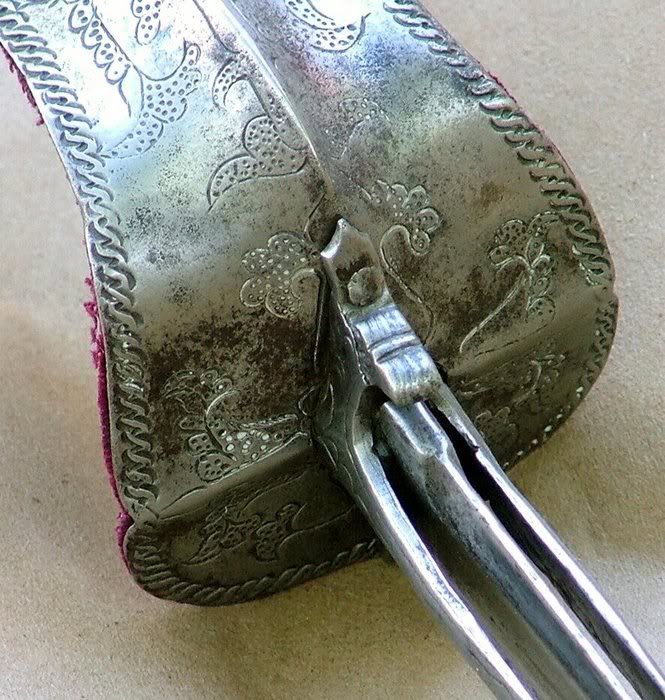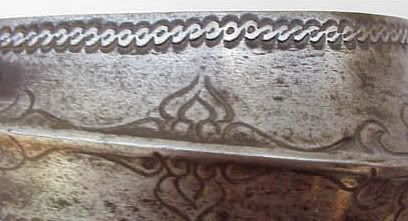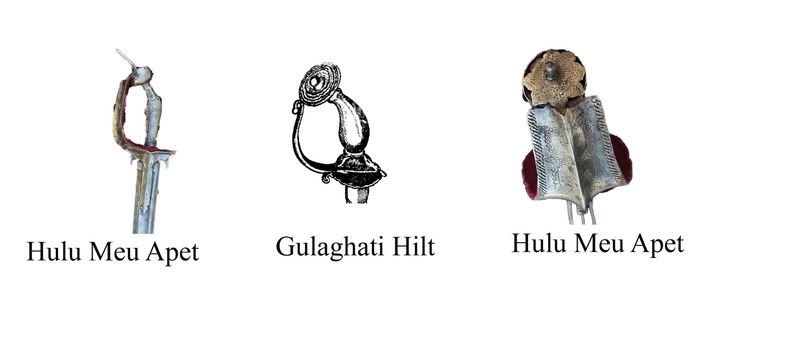
 |
|
|
#1 |
|
Member
Join Date: Dec 2004
Location: Italia
Posts: 1,243
|
Hi all, I'm back with three "new" pieces that I never show before on the forum: a mandau, a pedang 1 and a straight guradè (or saif as you preferr). Any commet, as usual, is very appreciated. Thank you
 P.S. any idea on the mandau hilt? why it's so different from the hilts that usual we can see on this weapons? Last edited by Flavio; 18th March 2007 at 02:15 PM. |
|
|

|
|
|
#2 |
|
Member
Join Date: Dec 2004
Location: Italia
Posts: 1,243
|
.
|
|
|

|
|
|
#3 |
|
Member
Join Date: Dec 2004
Location: Italia
Posts: 1,243
|
The pedang. The lamination on the blade is very beautiful! Who knows the meaning of the big H on the guard?
|
|
|

|
|
|
#4 |
|
Member
Join Date: Dec 2004
Location: Italia
Posts: 1,243
|
... and the guradè. The decoration is the same on both sides of the blade. Unfortunatly no rhino for the hilt

|
|
|

|
|
|
#5 |
|
Member
Join Date: Dec 2004
Location: Witness Protection Program
Posts: 1,730
|
the bottom one has the lion of judah. ethiopia, perhaps?
|
|
|

|
|
|
#6 |
|
Member
Join Date: Dec 2004
Location: Italia
Posts: 1,243
|
Hello Ron, yes the guradè has the lion of judah on one side and it's a tipical ethiopan sword. Regards
Flavio |
|
|

|
|
|
#7 |
|
Member
Join Date: Apr 2005
Posts: 3,255
|
Hello Flavio,
I like the pedang blade! The mandau looks very touristy IMVHO... Regards, Kai |
|
|

|
|
|
#8 | |
|
Member
Join Date: Dec 2004
Location: Italia
Posts: 1,243
|
Quote:
Are you serious Kai on the Mandau? |
|
|
|

|
|
|
#9 |
|
Member
Join Date: Apr 2005
Posts: 3,255
|
I think so but don't take my word for it! I hope Ben will chime in...
|
|
|

|
|
|
#10 | |
|
Member
Join Date: Dec 2004
Location: Italia
Posts: 1,243
|
Quote:
Hello Kai. The blade is very thick, heavy and well forged with a nice inlaid decoration and for sure all the piece seems to be an old one, but I'm not expert at all and I hope too that Ben, Michael or Arjan will join the thread. Regards Flavio |
|
|
|

|
|
|
#11 | |
|
Member
Join Date: Apr 2005
Posts: 3,255
|
Hello Flavio,
Quote:
However, the hilt looks really weird with very rough carving. I also don't think the scabbard or the side knife are very old. But I've been wrong before...  Regards, Kai |
|
|
|

|
|
|
#12 |
|
Member
Join Date: Jan 2007
Posts: 181
|
I don't know a lot about these, but aesthetically I'd have to agree on the first one, a very crude feel to it, "good enough for the stupid tourists with more money than taste". The blade may be heavy, but the workmanship on it is awfully crude. If I was an apprentice swordmaker I'd be afraid to show this to my master.....
 The other two blades more than make up for it though! Definitely nice examples of their types both of them. IF I had to accept one like the first one in order to get the next two, I think I could live with that! 
|
|
|

|
|
|
#13 | |
|
Member
Join Date: Dec 2004
Location: Virginia
Posts: 520
|
Quote:
A very nice peudeueng peusangan with a hulu meu apet ( pedang type 1). I believe the pattern you talk about is just a vegetative motif. If is seen on many hulu meu apet, I will try to post some more pictures soon of some. The floral motifs seen in Aceh are very common on weapons. Geometric and vegetative motifs are often symetrical. And very often enclosed in lines or borders. While it would be an H in the latin alphabet I am pretty sure they mostly use the arabic alphabet there. I hope someone here can add more on this Maybe Utami will see this soon he is our man on the ground so to speak on these swords. Or Albert he certainly will have some good input on it. |
|
|
|

|
|
|
#14 |
|
Member
Join Date: Dec 2004
Location: Virginia
Posts: 520
|
Some images
   Some on Artzi's site http://www.oriental-arms.com/photos/...02262/ph-4.jpg http://www.oriental-arms.com/photos/...02168/ph-4.jpg http://www.oriental-arms.com/photos/...01161/ph-5.jpg http://www.oriental-arms.com/photos/...02189/ph-4.jpg Last edited by RhysMichael; 19th March 2007 at 02:33 AM. |
|
|

|
|
|
#15 |
|
Member
Join Date: Jan 2006
Location: Kent
Posts: 2,658
|
Hi Flavio,
Congrats... I really like the Pedang..  ..the influence of Hindu weapons seems unmistakable with the example you've posted. The hilt is great (very Khanda-ish) and the blade looks fantastic. ..the influence of Hindu weapons seems unmistakable with the example you've posted. The hilt is great (very Khanda-ish) and the blade looks fantastic. The blade on the Gurade is also very nice.....is it European ? My knowledge of SEA weapons could be written on a postage stamp.....but the blade on the Mandau seems quite modern, the hilt has very little wear or patina. (yesterday I posted a recent Mandau.....functional, well balanced and basic with a good forged blade...but 40+ years old) Regards David |
|
|

|
|
|
#16 | |
|
Member
Join Date: Dec 2004
Location: Virginia
Posts: 520
|
Quote:

|
|
|
|

|
|
|
#17 |
|
Member
Join Date: Dec 2004
Posts: 987
|
Regarding the mandau, we just had a very excellent talk at the Timonium seminar on the subject, which informed that the carving on the handle had very strong religious significance. The stylized motifs each represented a specific aspect of the Dyak cosmology, and the mandau as a whole was meant to represent the cosmos in a way. Erik said that sometimes months, or even a year, were taken to carve the handle.
In view of that, it seems very odd that the handle on this one is so roughly done and relatively unadorned. The lens shapes though are, I think, one of the traditional motifs - the leech. |
|
|

|
|
|
#18 |
|
Member
Join Date: Dec 2004
Location: Italia
Posts: 1,243
|
Hi all and thank you for your comments. On the Mandau: maybe from pictures it's hard to say but the blade is very nice and not crude at all with a beautiful inlaid work. I don't want to defende at any cost my piece but could be well that was collected early as the seller says: "The sword brought to the Netherlands by a Duth captain of the KPM steam package service who died in 1934. His first journey was in 1887 according to his grandson" Maybe this piece never had taken heads, as Ben would say, but I think that is quite old (early 900 at least), but i'm not an expert.
For the handle: we see also good mandaus with completly undecorated hilts, but maybe this is not the case. Just thoughts for discussion 
|
|
|

|
|
|
#19 |
|
Member
Join Date: Dec 2004
Location: Italia
Posts: 1,243
|
Thank you very much John, as usual your help is fundamental! Yes the decoration seems an H for latin alphabet, but for arabic alphabet maybe means other or nothing (just decoration). But could be that this kind of decoration was influenced by the Dutch? Just an idea

|
|
|

|
|
|
#20 |
|
Member
Join Date: Dec 2004
Location: Italia
Posts: 1,243
|
For the guradè, if I'm not wrong, Roano (ROANOA) told me that the blade is German of the end of '800, but without the GG stamped.
|
|
|

|
|
|
#21 |
|
Member
Join Date: Dec 2004
Posts: 951
|
Hi I am sorry but the mandau is an new one the handle is poorly carved and also the side knife and the blade.
And I never read about that carving an Handle take s a year Mark. The Dajaks are expert in nice carvings Take a good look at the pics you can see what an handle and scabbard have to look like I am not an expert but before anyone buy s a weapon get good informed and visit an museum online or look for some good books and information and an real old nice mandau are hard to get . but that count for most other weapons too I think. Ben |
|
|

|
|
|
#22 | |
|
Member
Join Date: Dec 2004
Location: Virginia
Posts: 520
|
Quote:
Erik was telling me this weekend about an old book on Aceh that sounds like a great reference. I hope to be able to find a copy of it and if so I will check there also. |
|
|
|

|
|
|
#23 |
|
Member
Join Date: Dec 2004
Location: Italia
Posts: 1,243
|
Ben, thank you for your suggestion, I will do so for my future purchases, you're perfectly correct saying that before to buy one have to know more
 John, thank you very much I will look forward to see if you'll be able to find more 
|
|
|

|
|
|
#24 |
|
Member
Join Date: Nov 2006
Location: The Netherlands
Posts: 2,238
|
Dear Flavio,
This mandau does not look like a traditional pieces that has been used. But I have seen this type before and they always appear to have some age. They are often a bit bigger and heavier than you would expect a mandau to be. and they are made much more rough / crude than a mandau for real use. The decorations are simpler, as on this one, the sideknifescabbards are often made of leather instead of bark. But they are decorated with old beads and tufts of hair, as on this one. I have now good info on the age, but I would think it to be an early tourist item. Best regards, Willem |
|
|

|
 |
|
|